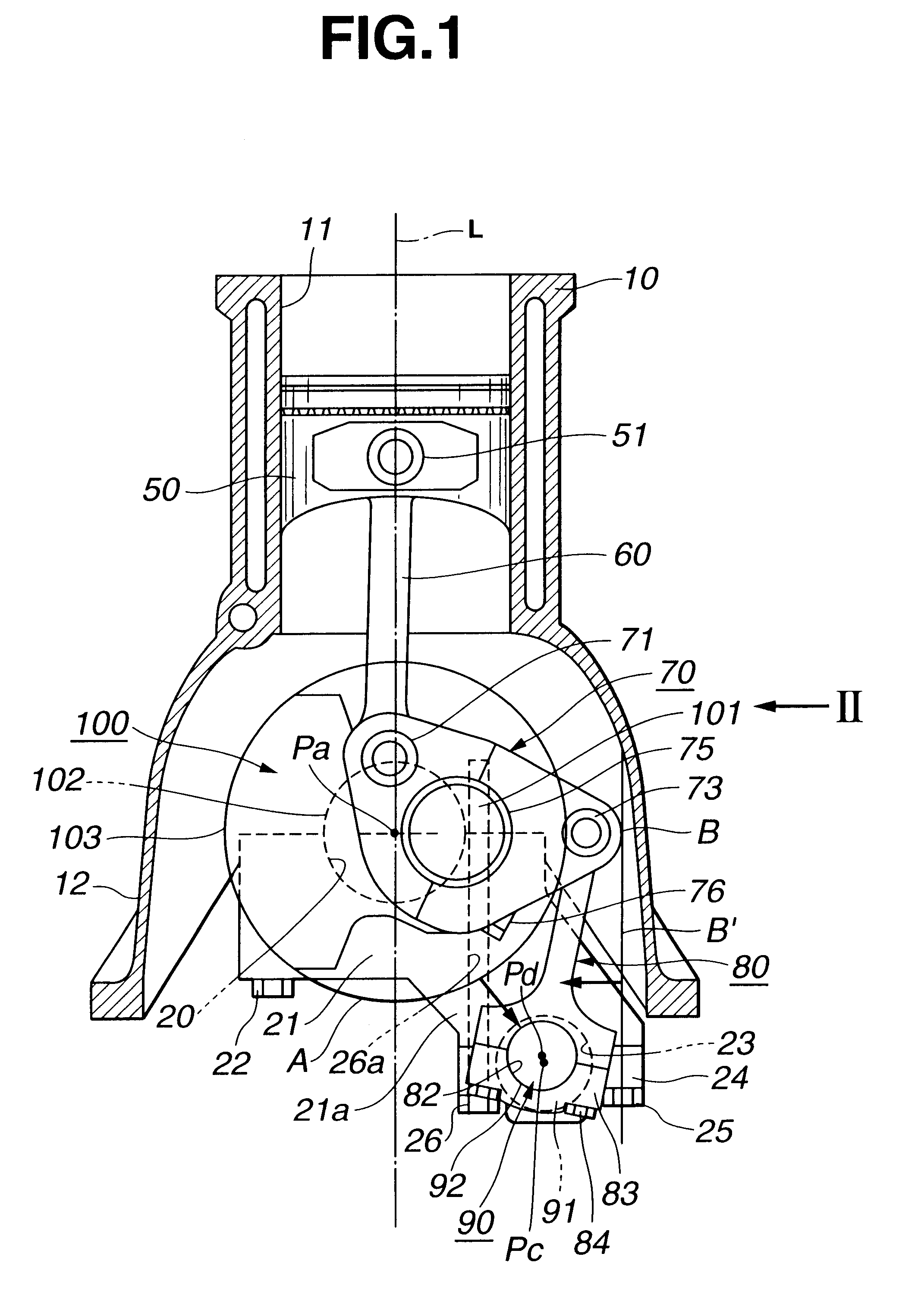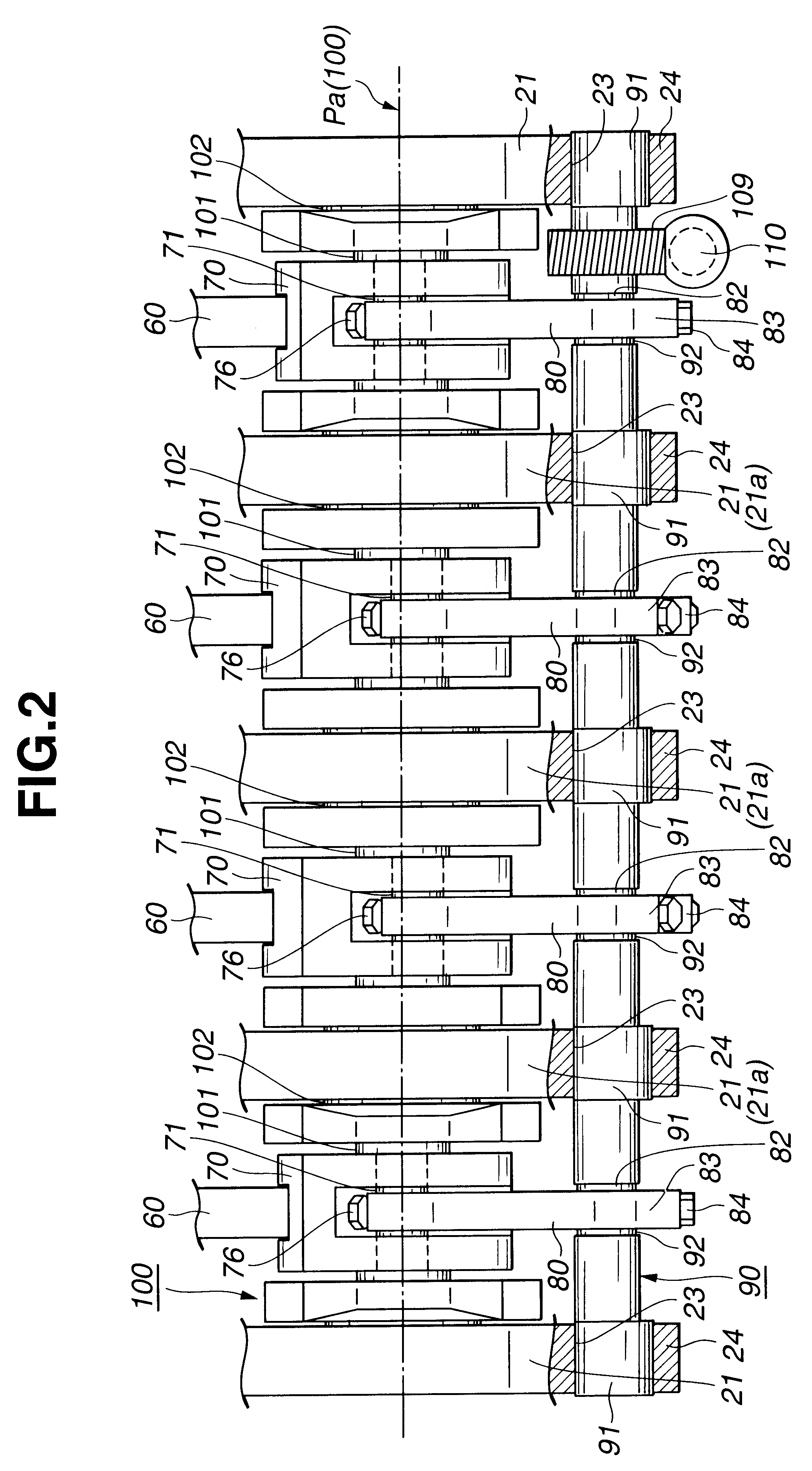Internal combustion engine with variable compression ratio mechanism
a technology of compression ratio and internal combustion engine, which is applied in the direction of combustion engine, crankshaft bearing, crankshaft bearing, etc., can solve the problem of providing the engine with a compact construction
- Summary
- Abstract
- Description
- Claims
- Application Information
AI Technical Summary
Benefits of technology
Problems solved by technology
Method used
Image
Examples
first embodiment
Referring to FIGS. 1 to 4, there is shown an internal combustion engine with a variable compression ratio mechanism, which is the present invention.
The engine having the variable compression ratio mechanism incorporated therewith is of a four cylinder type.
As is well seen from FIGS. 1 and 2, the variable compression ratio mechanism comprises four upper links 60 each having one end pivotally connected to a piston pin 51 of a corresponding piston 50, four lower links 70 each being pivotally disposed on a crank pin 101 of a crankshaft 100 and having one end pivotally connected through an upper link pin 71 to the other end of the corresponding upper link 60, a control shaft 90 located at a right lower side of the crankshaft 100 (in FIG. 1) and extending in parallel with the crankshaft 100 and four control links 80 each having a lower end pivotally connected, through an aftermentioned eccentric bearing structure, to the control shaft 90 and an upper end pivotally connected through a cont...
second embodiment
Referring to FIGS. 12 to 14, there is shown an internal combustion engine of the present invention.
In this second embodiment, to each of the bearing caps 21A for the crankshaft 100, there is integrally connected the bearing portion 23 for the control shaft 90. That is, as is seen from FIG. 13, the bearing cap 21A is integral with the bearing portion 23. Unlike in the above-mentioned first embodiment, the bearing portion 23 has not a split structure, and thus in the second embodiment, there are no members corresponding to the bearing caps 24 and the connecting bolts 25 which are used in the first embodiment. Although the facility of assembling the control shaft 90 to the bearing portion 23 is somewhat poor as compared with the first embodiment, reduction in number of parts and simplification of the construction are achieved in the second embodiment.
third embodiment
Referring to FIGS. 15 to 17, there is shown an internal combustion engine of the present invention.
In this third embodiment, to lower surfaces of the bearing caps 21B, there is secured a bearing beam 30. As is seen from FIG. 17, the bearing beam 30 comprises a plurality of branch plate portions 35 which are secured to the lower surfaces of the bearing caps 21B and an elongate base plate portion 34 which connects the branch plate portions 35 integrally.
As is seen from FIG. 16, the bearing beam 30 is formed with bearing portions 31 for the control shaft 90. Each bearing portion 31 has a split structure for facilitating the work for assembling the control shaft 90 thereto. That is, each bearing portion 31 comprises a rounded recess formed in a lower surface of the branch plate portion 35 of the bearing beam 30 and a rounded recess formed in an upper surface of a bearing cap 32 which is bolted to the lower surface of the branch plate portion 35.
As is understood from FIG. 17, the bearing...
PUM
 Login to View More
Login to View More Abstract
Description
Claims
Application Information
 Login to View More
Login to View More - R&D
- Intellectual Property
- Life Sciences
- Materials
- Tech Scout
- Unparalleled Data Quality
- Higher Quality Content
- 60% Fewer Hallucinations
Browse by: Latest US Patents, China's latest patents, Technical Efficacy Thesaurus, Application Domain, Technology Topic, Popular Technical Reports.
© 2025 PatSnap. All rights reserved.Legal|Privacy policy|Modern Slavery Act Transparency Statement|Sitemap|About US| Contact US: help@patsnap.com



